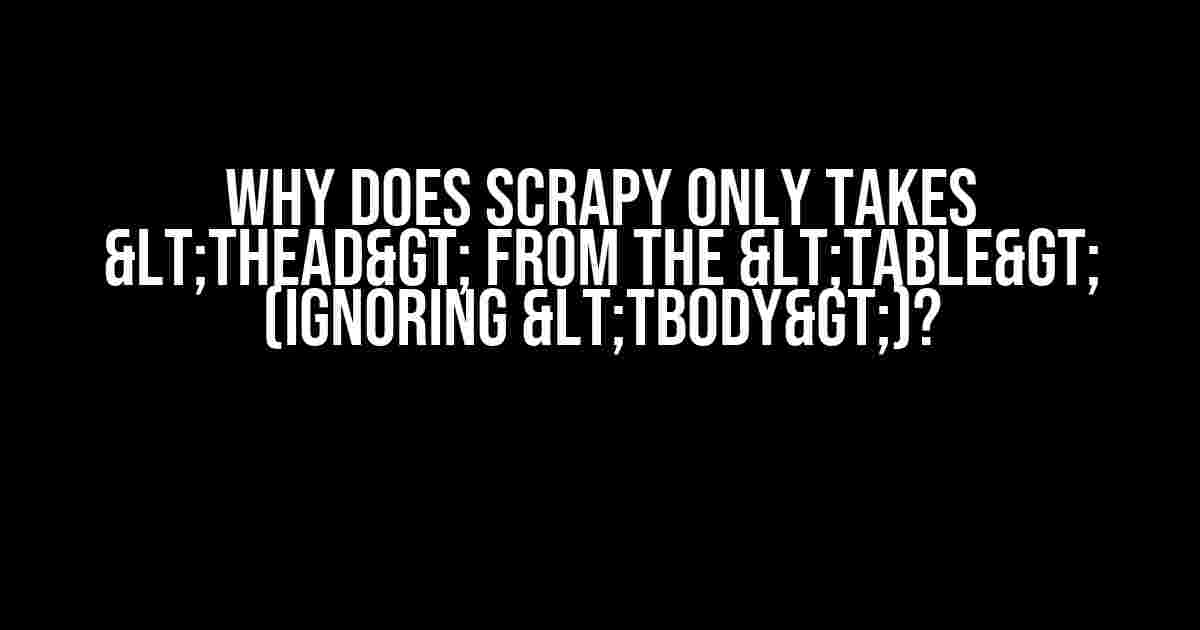Are you frustrated with Scrapy only extracting the <thead> part of an HTML table, leaving behind the precious data in the <tbody> section? You’re not alone! In this article, we’ll dive into the reasons behind this behavior and provide you with practical solutions to overcome this hurdle.
The Mystery of the Missing <tbody>
Before we dive into the solution, let’s understand why Scrapy behaves this way. Scrapy is a powerful web scraping framework that uses a CSS selector to extract data from HTML pages. By default, Scrapy uses the lxml library to parse HTML pages. This library is optimized for speed and performance, but it has some quirks that can cause issues like the one we’re facing.
The Role of <tbody> in HTML Tables
In HTML, the <tbody> element is used to group rows of a table that belong to the table body. It’s an optional element, and browsers are smart enough to infer its presence even if it’s not explicitly defined. However, when it comes to parsing HTML tables, the <tbody> element is often ignored or omitted.
Why is that? Well, the HTML specification states that a table can have multiple <tbody> elements, but in practice, it’s common for tables to have only one <tbody> section. As a result, many HTML parsers, including lxml, choose to ignore the <tbody> element and focus on the <tr> elements instead.
Solution 1: Use the `tbody` selector explicitly
One way to overcome this issue is to explicitly specify the <tbody> selector in your Scrapy spider. You can do this by modifying the CSS selector used to extract the table data.
import scrapy
class MySpider(scrapy.Spider):
name = "my_spider"
start_urls = [
'https://example.com/table_page',
]
def parse(self, response):
table_data = response.css('table > tbody > tr')
# Process the table data
In this example, we’re using the CSS selector `table > tbody > tr` to extract the <tr> elements within the <tbody> section. By explicitly specifying the <tbody> selector, we ensure that Scrapy extracts the entire table body.
Solution 2: Use the `html` library instead of `lxml`
If you’re using Scrapy 1.8 or later, you can opt to use the `html` library instead of `lxml` for parsing HTML pages. The `html` library is more lenient when it comes to parsing HTML tables and will correctly handle the <tbody> element.
import scrapy
from scrapy.linkextractors import LinkExtractor
from scrapy.loader import ItemLoader
from scrapy.item import Item, Field
from scrapy.loader.processors import TakeFirst
from scrapy.selector import Selector
from scrapy.utils.response import get_base_url
from w3lib.html import remove_tags
from scrapy.crawler import CrawlerProcess
class MySpider(scrapy.Spider):
name = "my_spider"
start_urls = [
'https://example.com/table_page',
]
def parse(self, response):
table_data = response.css('table > tr')
# Process the table data
In this example, we’re using the same CSS selector `table > tr` to extract the <tr> elements, but this time, Scrapy will use the `html` library to parse the HTML page. The `html` library will correctly handle the <tbody> element, and we’ll get the entire table data.
Solution 3: Use a custom HTML parser
If you’re using an older version of Scrapy or prefer a more customized approach, you can write a custom HTML parser to handle the <tbody> element. This approach requires more effort, but it gives you total control over how the HTML page is parsed.
import scrapy
from scrapy.selector import Selector
from bs4 import BeautifulSoup
class MySpider(scrapy.Spider):
name = "my_spider"
start_urls = [
'https://example.com/table_page',
]
def parse(self, response):
soup = BeautifulSoup(response.body, 'html.parser')
table_data = soup.find_all('tr')
# Process the table data
In this example, we’re using the `BeautifulSoup` library to parse the HTML page. We’re telling BeautifulSoup to use the `html.parser` parser, which will correctly handle the <tbody> element. Then, we’re using the `find_all` method to extract all <tr> elements, which will include those within the <tbody> section.
Conclusion
In this article, we’ve explored the reasons why Scrapy might only extract the <thead> part of an HTML table, leaving behind the precious data in the <tbody> section. We’ve also provided three solutions to overcome this issue: using the `tbody` selector explicitly, using the `html` library, and writing a custom HTML parser.
By applying these solutions, you should be able to extract the entire table data, including the <tbody> section, and get the most out of your Scrapy spider.
| Solution | Description |
|---|---|
| Use the `tbody` selector explicitly | Specify the `tbody` selector in your Scrapy spider to extract the entire table body. |
| Use the `html` library | Use the `html` library instead of `lxml` for parsing HTML pages, which will correctly handle the `tbody` element. |
| Write a custom HTML parser | Write a custom HTML parser using a library like BeautifulSoup to handle the `tbody` element. |
Remember, when working with Scrapy, it’s essential to understand how the HTML parser handles different HTML elements, including the <tbody> section. By being aware of these quirks, you can write more effective Scrapy spiders that extract the data you need.
FAQs
-
Why does Scrapy ignore the <tbody> element?
Scrapy ignores the <tbody> element because the HTML parser used by default, `lxml`, is optimized for speed and performance, and it omits the <tbody> element.
-
How can I extract the entire table data, including the <tbody> section?
You can extract the entire table data by using the `tbody` selector explicitly, using the `html` library, or writing a custom HTML parser.
-
What’s the difference between the `lxml` and `html` libraries?
The `lxml` library is optimized for speed and performance, while the `html` library is more lenient when it comes to parsing HTML tables and will correctly handle the <tbody> element.
We hope this article has helped you understand why Scrapy might only extract the <thead> part of an HTML table and how to overcome this issue. If you have any more questions or need further clarification, feel free to ask!
Frequently Asked Question
Get ready to crawl into the world of Scrapy and unravel the mystery of why it only takes <thead> from the <table>, leaving <tbody> in the dark!
Why does Scrapy only take <thead> from the <table> when I’m trying to scrape a table?
Scrapy, by default, uses the lxml parser, which has a known issue where it only considers the first child of a table to be part of the table’s contents. In most cases, this is the <thead> element. To scrape the entire table, including the <tbody> contents, you can switch to the html5lib parser by adding CURLOPT_HTTP_PARSER = 'html5lib' to your settings.py file.
Is this a Scrapy-specific issue, or is it a problem with the HTML parser?
This is not a Scrapy-specific issue, but rather a limitation of the lxml parser. The lxml parser is known to have issues with parsing broken or malformed HTML, which can lead to unexpected behavior. In this case, it’s causing Scrapy to only consider the <thead> element.
How can I confirm that Scrapy is indeed using the lxml parser?
You can check Scrapy’s logs to confirm which parser is being used. Look for the message “Using parser lxml” in the logs. If you’re using a different parser, such as html5lib, you’ll see a corresponding message.
Will switching to the html5lib parser fix all table-scraping issues?
While switching to the html5lib parser can help with scraping entire tables, it’s not a silver bullet. You may still encounter issues with malformed HTML or tables with complex structures. Always inspect the HTML structure of the page you’re trying to scrape and adjust your Scrapy code accordingly.
Can I use CSS selectors or XPath expressions to target the <tbody> element directly?
Yes, you can use CSS selectors or XPath expressions to target the <tbody> element directly. For example, you can use the CSS selector table > tbody or the XPath expression //table/tbody to extract the <tbody> contents. However, keep in mind that this approach may still be affected by the parser’s limitations.



